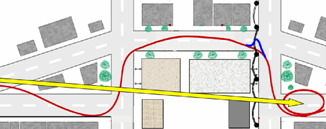|
Sponsor: AFRL-WPAFB (Mark Mears)
Collaborators: Jim Paduano (Aurora Flight Sciences), Tim Horiuchi (UMD)
 As micro air vehicles transition from demonstrators to field-usable vehicles, the necessity for avionics tailored to their unique needs becomes more severe. MAVs operating at low altitude in cluttered urban environments will encounter both large and small obstacles that may be fixed or moving, and whose position is not known in advance. In order to fully realize the benefits of these vehicles, they must incorporate autonomous detection and avoidance capabilities. Given the tight resource constraints on MAVs, the challenge is not just to enable these capabilities, but also to implement them within a small and light enough package to be accommodated on a MAV, without requiring too much power. As micro air vehicles transition from demonstrators to field-usable vehicles, the necessity for avionics tailored to their unique needs becomes more severe. MAVs operating at low altitude in cluttered urban environments will encounter both large and small obstacles that may be fixed or moving, and whose position is not known in advance. In order to fully realize the benefits of these vehicles, they must incorporate autonomous detection and avoidance capabilities. Given the tight resource constraints on MAVs, the challenge is not just to enable these capabilities, but also to implement them within a small and light enough package to be accommodated on a MAV, without requiring too much power.
In this project we combine optic flow based negotiation through mid-field clutter using wide-field integration (WFI) techniques (Humbert), active sensing of imminent collisions using bat-inspired echolocation sensing (Horiuchi), and hierarchical application of behavioral and automaton-based navigation and maneuvering strategies (Paduano) to enable autonomous vehicles to conduct military intelligence, surveillance, and reconnaissance (ISR) missions in challenging and uncertain environments.
|

J. Sean Humbert, Ph.D.
Techno-Sciences Associate Professor of Aerospace Engineering Innovation
3182 Glenn L. Martin Hall
University of Maryland
College Park, MD 20742
301.405.0328 TEL
301.314.9001 FAX
humbert (at) umd.edu
|

 As micro air vehicles transition from demonstrators to field-usable vehicles, the necessity for avionics tailored to their unique needs becomes more severe. MAVs operating at low altitude in cluttered urban environments will encounter both large and small obstacles that may be fixed or moving, and whose position is not known in advance. In order to fully realize the benefits of these vehicles, they must incorporate autonomous detection and avoidance capabilities. Given the tight resource constraints on MAVs, the challenge is not just to enable these capabilities, but also to implement them within a small and light enough package to be accommodated on a MAV, without requiring too much power.
As micro air vehicles transition from demonstrators to field-usable vehicles, the necessity for avionics tailored to their unique needs becomes more severe. MAVs operating at low altitude in cluttered urban environments will encounter both large and small obstacles that may be fixed or moving, and whose position is not known in advance. In order to fully realize the benefits of these vehicles, they must incorporate autonomous detection and avoidance capabilities. Given the tight resource constraints on MAVs, the challenge is not just to enable these capabilities, but also to implement them within a small and light enough package to be accommodated on a MAV, without requiring too much power. 